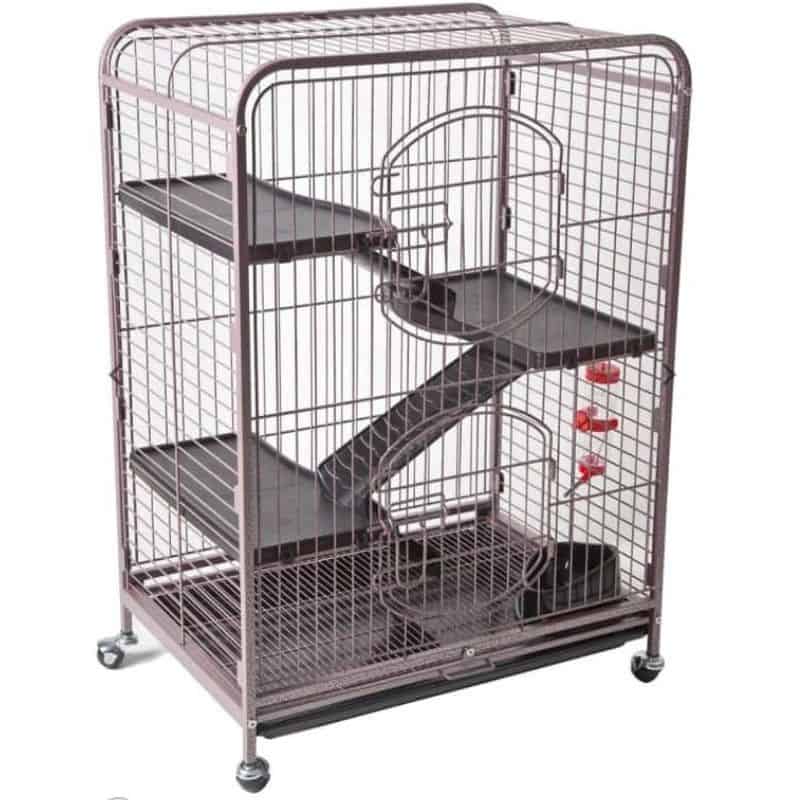Ferrets
What You Should Know About Ferret Cages
Ferrets are energetic creatures that thrive with ample playtime outside their cages, typically requiring three to four hours of activity daily. However, most of their time is spent within their enclosures, so providing a comfortable and well-designed cage is important.
Modern ferret cages come in a range of shapes, designs, and features. Some feature solid floors, while others incorporate built-in shelves or multi-level platforms. However, the fanciest cage isn’t necessarily the best choice for your furry friend.
Whether you’re considering a common or distinctive breed of ferret, it’s crucial to prioritise their well-being beyond aesthetics. As a responsible owner, ensuring your ferret’s comfort and happiness throughout their stay is paramount. Therefore, before selecting a cage, consider the following factors:

What To Look For In A Cage
With a choice of ferret cage designs available online, selecting the right one requires careful consideration. Prices vary based on materials and complexity, but you can still find budget-friendly options.
An ideal ferret cage should offer ample space for essentials like food and water bowls, bedding, a litter pan, and room for play.
Ferret cages are typically constructed with coated metal bars spaced no wider than one inch to prevent escapes or accidents. Additionally, they feature a solid plastic floor and a secure locking mechanism on the door for safety.
Some cages include added features like ramps and ladders, but it’s best to avoid metal mesh for these components, as it can be uncomfortable and potentially harmful to your pet’s feet. If your cage does have metal mesh, consider covering it with softer materials like linoleum or vinyl to provide a more suitable surface.
Cleaning doesn’t have to be a hassle, as linoleum and vinyl tiles can be wiped clean with minimal effort.

What to Put In A Ferret Cage
In a ferret cage, you should include:
Food and Water Bowls: Provide sturdy bowls for food and water that can’t be knocked over easily, or drinkers that attach to the side of the cage, to ensure your ferret has access to fresh food and water at all times.
Bedding: Choose appropriate bedding material such as fleece blankets, towels, or specially designed ferret bedding to keep your pet cosy and comfortable.
Litter Box: Place a litter box filled with appropriate litter material in a corner of the cage to encourage your ferret to use it for their bathroom needs.
Toys and Enrichment: Include a variety of toys and enrichment items to keep your ferret mentally stimulated and physically active. Toys such as tunnels, balls, and chew toys are great options.
Hammocks or Hideouts: Provide hammocks or hideouts where your ferret can rest and feel secure. Ferrets enjoy climbing and exploring, so having elevated resting spots is beneficial.
By including these essentials in your ferret’s cage, you can create a comfortable and enriching environment for your furry friend to thrive in.

Cage Maintenance
Maintaining cleanliness is crucial for the overall well-being of your pet ferret. A clean cage not only promotes its health but also ensures a pleasant environment for those around you.
It’s important to change and wash your ferret’s food and water bowls at least once daily to ensure they have fresh and clean water and prevent them from ingesting anything contaminated.
Similarly, the litter tray should be emptied daily, and if you notice soiled bedding or coverings, they should be promptly removed. Disposable bedding should be discarded, while reusable bedding should be washed.
When cleaning the cage, remove all items and wash them thoroughly with mild detergent or pet-safe cleaning products. Ensure all items are completely dry before returning them to the cage to maintain a hygienic environment for your pet ferret.
Cage Placement
When deciding where to place your ferret’s cage, consider the following factors:
Indoor Location: Ferrets are indoor pets, so their cage should be placed indoors where they can be a part of your daily life. Choose a quiet area away from excessive noise and foot traffic to provide a calm environment for your ferret.
Temperature: Ferrets are sensitive to temperature extremes, so avoid placing their cage in areas with direct sunlight, drafts, or near heating vents or air conditioners. Aim for a location with a stable temperature between 15-27°C.
Ventilation: Ensure proper ventilation in the area where the cage is placed to maintain good air quality for your ferret’s health and prevent unpleasant odours in the surrounding environment.
Accessibility: Place the cage in an area where you can easily access it for feeding, cleaning, and interaction with your ferret.
Security: Make sure the location is secure and free from potential hazards that could harm your ferret if it were to escape from the cage.
Socialisation: Ferrets are social animals and enjoy being around their human companions. Place the cage in a room where your ferret can interact with family members and observe household activities.
Overall, choose a quiet, comfortable, and safe location for your ferret’s cage, ensuring it meets their physical and social needs for a happy and healthy life.
Ian’s Wrap
A ferret’s cage isn’t just a containment area—it’s their sanctuary. By prioritising space, cleanliness, and enrichment, you create an environment where they can thrive. Choose wisely, maintain their cage environment, and provide creative enrichment for a happy, healthy ferret companion.



